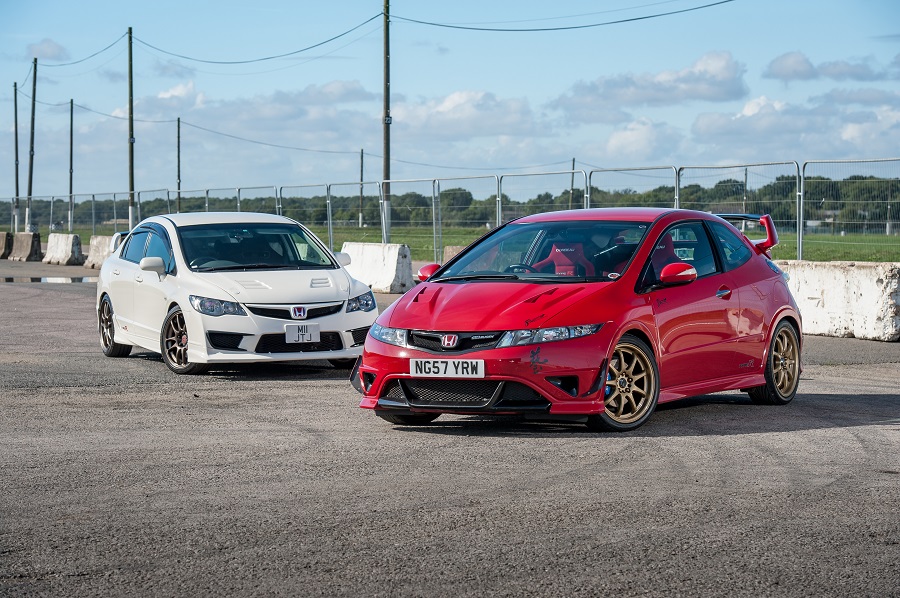FN2 vs FD2 Type R – which is better? Well, to have a go at answering that question, we pitted two great modified examples against each other.
Words: Guy Baker, Pics: Dan Sherwood
When a seminal sports car reaches the end of its production cycle, the model that replaces it is – almost invariably – seen as less inspiring. Witness Subaru’s ‘new age’ Impreza, the Nissan 370Z and the Mk2 Mazda MX-5. And so it was too when the 2007 FN2 replaced the big-hitting EP3 Honda Civic Type R. Road testers still admired the drive but claimed the Type R hatchback had lost something of its hard-core edge and become perhaps a bit too grown up. That didn’t stop it from selling in large numbers, and as such, you can pick up a very reasonable FN2 for just £5000.
Honda’s high-revving VTEC power-plants have of course endowed the Civic Type R with a unique character ever since the very first of the breed – the EK9 – appeared in 1997. A practical character combined with motorsport trappings mark out the Type R sub-brand as highly desirable. And the passage of time, plus the emergence of more recent turbocharged models, now positions the highly affordable FN2 in a very different light. Plus, that low price tag leaves more money aside for modifications.
The same can’t be said however about the FN2’s more aggressive sibling, the JDM-only FD2 Type R Saloon. An altogether different animal, the FD2 offers more power than the FN2, better performance and far greater exclusivity outside of Japan. You really have to want one though, with most examples costing £19,000 or more – a £7000 premium over the similarly-spec’d DC5 Integra Type R.
Overall though, how do these third-gen Type Rs truly compare? FN2 vs FD2 Type R: let’s find out…
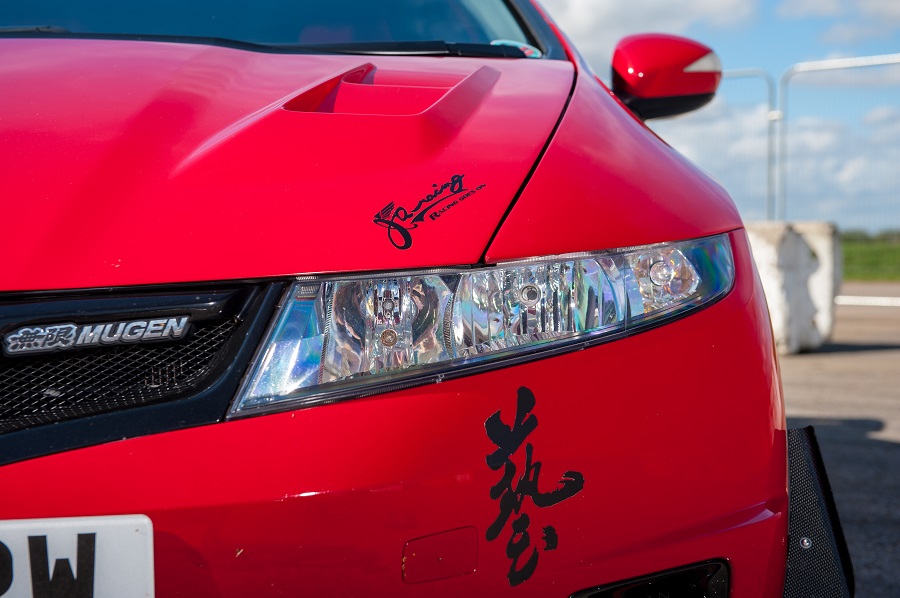
FN2 vs FD2 Type R: FN2 Model History
The UK/EU FN2 Civic Type R offered a more comfortable high-speed cruising capability than the previous EP3 – with increased sound deadening, improved ride quality and less frantic gear ratios – but still delivered similar performance. The 198bhp hatchback hit 62mph in 6.6 seconds on the way to a 146mph top speed and cost just £17,600, or £18,600 for the better-equipped GT model when new. 18in alloys, electric heated mirrors, aluminum footrests and drilled pedals, Type R sill plates, an alloy gearknob with red stitched leather, a big red starter button, a rev limit warning and Alcantara sports seats were all standard; whilst the GT model added cruise control, folding door mirrors, automatic headlights, front foglights, climate control, rain-sensing wipers and a refrigerated glovebox.
A minor face-lift in October 2008 saw a Championship White Edition with a limited-slip diff and white wheels, but the pick of the FN2 models – the limited edition 237bhp Civic Type R Mugen – arrived in 2009. Priced at an eye-watering £38,599 the 2.0-litre car received the full Mugen motorsport treatment. Just 16 UK cars were sold, but at least four more were made available in 2011 reworked by Mugen to 2.2-litres and 260bhp.
All FN2s came with a limited-slip diff from late 2009 and Honda marked the end of production with a 2010 Type R Mugen 200 limited edition, boasting Championship White Mugen styling – but lacking the Mugen performance options. Honda sold 11,615 FN2 models in the UK, but even more FD2 Type Rs were sold in Japan – over 13,000 in total.

FN2 vs FD2 Type R: FD2 Model History
The 2007-on Type R FD2 Saloon boasts a higher 11.7:1 compression ratio and produces 222bhp at 8400rpm, plus greater torque too. As a result the JDM car has a faster 6.3-second 0-62mph time, plus an elevated 149mph top speed. The larger wheelbase gives the FD2 a more stable stance in high speed cornering too and came with 18in alloys as standard, plus plenty of exclusive kit – like bumpers, front grille, rear diffuser, boot spoiler, a red engine cover, drive-by-wire throttle control, a hard setting suspension, larger brakes with Brembo 4-pot brake calipers, a torque sensing helical limited-slip diff, a revised ABS/EBD system and auto-levelling HID headlights. Plus the FD2 also features independent rear suspension – rather than the torsion beam configuration used on the FN2.
In October 2008, as with the FN2, the FD2 received a minor face lift. Then, in 2009 the limited edition 240bhp 2.0-litre Milano Red FD2 Mugen RR saloons (to match the UK Mugen model) emerged, as well as an unknown number of reworked 260bhp 2.2-litre FD2s.
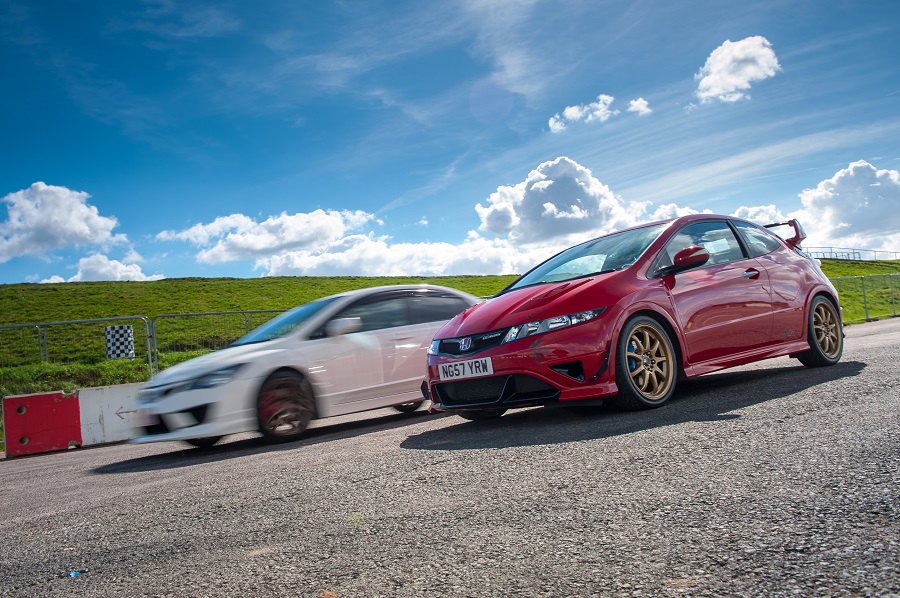
FN2 vs FD2 Type R: Driving Dynamics
Compared to the previous EP3 model the factory-spec FN2 boasts improved steering feel, is responsive and balanced on the limit and feels very much at home around bends. There is a degree on understeer evident on faster corners but the FN2 changes direction quickly and accurately without any drama whilst the brakes inspire confidence even in standard trim.
The driving position too feels great, and the six-speed manual gearbox with its super-short throw and slick action begs you to drive the Honda hard. Sometimes you do need to change down to overtake, but you’ll enjoy doing so – when you enter the VTEC zone the engine screams delightfully as the Type R pulls like it possesses a small turbo. Jump into a standard FD2 Saloon however and you realise that – good though the FN2 is as a driving tool – the FD2 is even better.
Not only is it a tad quicker, the handling is finer too. In fact, it’s a cracking car – with a setup that’s suited to the track straight out of the box. Agile, with better steering feel, all models come with an LSD and the braking is seriously strong – good enough even for those who will seek to add forced induction. High-speed stability is better too. But there is a downside. The factory suspension is really hard on the road. So some kind of revised suspension is essential if you’re planning to use an FD2 as a daily driver. Note too that the rear seats don’t fold down.
A tough choice then, but whichever Type R you choose, the driving experience is guaranteed to be an involving one. Both versions are brilliant fun when blasting down B-roads – but you do need to work them hard. As a result, they can leave you feeling tired on longer journeys.
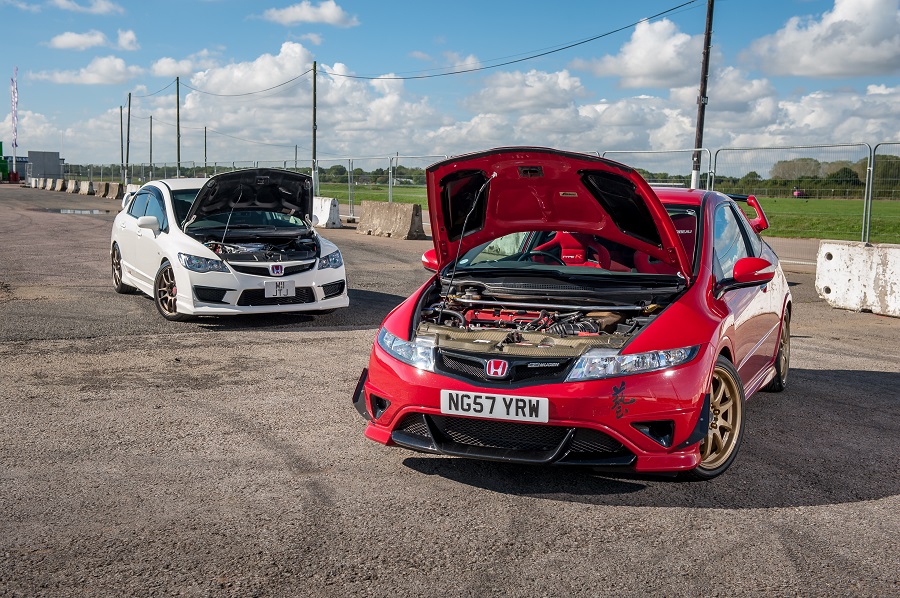
FN2 vs FD2 Type R: Engine Tuning
With both cars sharing much in common the recommended tuning routes are understandably very similar. And whilst the FD2 has a clear edge in standard guise, when you add forced induction to an FN2, the JDM model loses its advantage. Factor in the fact that a decent FN2 will set you back as much as £12,000 less to buy in the first place and it’s no surprise that most buyers planning serious tuning opt for a UK model instead.
What Do The Specialists Say?
‘Sharing similar engine components from the earlier K20A has made the FN2 and FD2 immediately accessible to aftermarket tuning,’ confirms TDi North. And owners looking for substantial returns choose to either supercharge or turbocharge their Type R. That said, UK tuning hasn’t been limited to forced induction: ‘A freer-breathing, normally-aspirated, remapped UK FN2 is still quite capable of delivering an extra 40bhp,’ emphasizes Type R experts CPL Racing. But this route won’t deliver as much bang for your buck.
If you do opt for forced induction it’s important that you seek out the services of a truly experienced tuner as there are some key elements that must not be overlooked. ‘Type Rs don’t respond quite as well without one or two tweaks,’ TDi North explains. ‘Honda introduced an oil pump system with balancer shafts which, although making the motor smoother, also introduced some power losses.’ As a result some FN2 owners choose to replace their car’s OE oil pump with an EP3-spec version.
Fitting forced induction on a JDM FD2 is a less common strategy with UK owners – probably because the factory car claims finer performance as standard, and with a lower compression ratio the UK FN2 is actually more suited to forced induction. An FD2 would need fewer supporting mods however (aside from the similar engine work) with little need to modify the suspension and brakes for example – thus arguably making a better starting point.
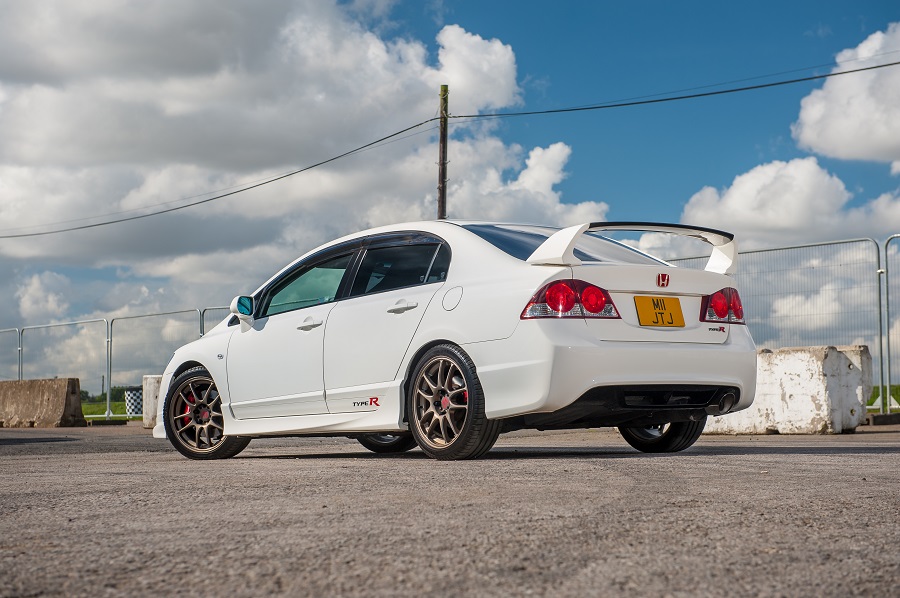
Mark Partington’s Modified FD2
That was certainly part of the thinking as far as owner Mark Partington was concerned. Although his mint white FD2 hasn’t as yet been treated to forced induction, fitting a TTS Performance Rotrex supercharger is definitely on the cards in the long term.
Having owned three previous Type Rs the exclusivity of the model was also very important to Mark: ‘The best thing about this car is the rarity and the styling,’ Mark tells us. ‘I’ve always liked the shape and after owning an Integra DC5 this was the logical next step for me.’ His wife certainly knows he’s mad about cars, and his kids – although young – already seem to share Mark’s admiration for his FD2. And you can’t ignore the saloon’s obvious practicality.
Tasteful Enhancements
‘I think the modifications on the exterior just make my FD2 look better, but the remap makes the car so much better to drive day to day,’ Mark makes clear. His car’s performance modifications so far – a Hybrid Racing cold air intake, a decat exhaust, a Flashpro ECU with a custom remap to 253bhp and some Tein Super Street coilovers with EDFC have enhanced the driving experience significantly. And the key styling changes like the Work Emotion CR Kai alloys, a Seibon carbon-fibre bonnet, a Mugen lip spoiler and some J’s Racing air ducts blend tastefully with the FD2’s existing factory kit.
Mark had some help with some of the work: ‘My brother helped me with the bonnet and grille as he’s a painter, and he also helped with fitting it and refurbing the edges of the alloys, as they were kerbed when I bought them.’ Grinspeed Motorsport fitted the Eibach camber arms and set the full road set up, as well as fitting the hydrid cold air intake, whilst TDi North were responsible for Mark’s custom remap.
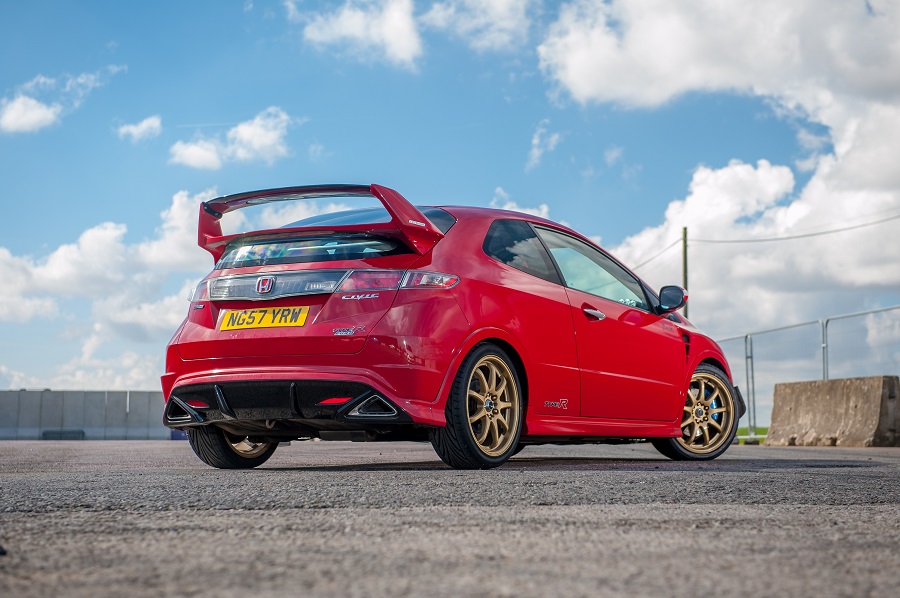
David Haswell’s Modified FN2
Grinspeed Motorsport also had a hand in modifying David Haswell’s impressive FN2, which boasts a long list of engine mods including a J’s Racing manifold and exhaust, porting of the FD2 RRC manifold to match the Spoon TB Clockwise Motion top end with Stage 2 cams and valves, a Mugen oil sump, an FD2 oil pump with balance shaft delete kit, a Tegiwa intake, Spoon plug cover, J’s Racing radiator hoses and a Flashpro remap to around 260bhp.
‘The idea behind the Type R was to make a racecar for the street,’ David recounts, ‘And even when my car was in standard form that’s how it felt. People might argue the FN2 was a flawed version compared with the EP3 or the FD2 but with a few modifications the FN2 can hold its own against the FD2.’ I sourced All the J’s Racing parts through Sumopower with the rest of the bits coming from Injection Imports, with fitting at Grinspeed. ‘The car was then mapped by Vit Viper,’ David explains, and then detailed by Total Valets Redcar.
Mugen Dreams
Like most owners David found plenty of help and information on the Type R owners’ forum and Civinfo.com along the way, and his end goal was always to reproduce something similar to Mugen’s red prototype car in terms of styling and power. And although he hasn’t always stuck with Mugen parts, in terms of the complete package of styling, handling, braking and performance, it must be somewhere near the prototype car.
David had also owned three previous Type R Hondas and bought this red FN2 back in 2009. ‘Coming from an EP3 to an FN2 a criticism was the harsh ride and lack of independent rear suspension. I tried to address this by fitting Mugen suspension which offered more grip, better control and an improved ride. While the ride is still harsh compared with my old EP3, in my opinion, it is far more controlled and capable.’
‘Yes the FN2 is heavier,’ David admits, ‘And initially that’s why I went down the exhaust, intake and then drop-in cam-shaft route. But I ended up going that one step further and fitting a K20 with a Clockwise Motion flowed head and Stage 2 cams and valve train after my original engine failed – courtesy of a sand blasting mishap. As a package David feels his modifications have made the car feel much quicker than any of his previous Type R’s and closer to the raw racecar feel of his other current Type R – a standard EK9. After the shoot, Mugen front and rear lower spoilers will be going on the car, and then that’ll be that, David claims. Time will tell – we reckon the lure of forced induction might eventually prove irresistible!
Tech Spec: David Haswell’s FN2 Type R
Engine
J’s Racing manifold and exhaust, FD2 RRC manifold (ported to match Spoon TB), Spoon TB Clockwise Motion top end (flowed head with Stage 2 cams and valve train), Mugen oil sump, FD2 oil pump (Balance Shaft delete kit), Tegiwa Intake, Spoon plug cover, J’s Racing radiator hoses, Flashpro remap approx. 260bhp
Transmission
M Factory Final Drive 5.46, Clockwise Motion Flywheel, Quaife LSD
Suspension
Full set of J’s Racing chassis braces, Rigid Collar Kit, Mugen Sports Suspension
Brakes
Spoon Monoblock Callipers, Spoon pads, HEL Brake lines, EBC discs, Standard Rear Brakes
Wheels & Tires
Work Emotion XD9’s with Toyo TR1 Proxies
Exterior
Mugen Grill, Fenders, rear wing, J’s Racing Bonnet, J’s Racing LED red H badge, Honda, GP Kit front and rear spoilers, J’s Racing canards
Interior
Corbeau RRS reclining seats, Mugen Assist gauges, J’s Racing Carbon Steering wheel, J’s Racing Titanium gear knob
Tech Spec: Mark Partington’s FD2 Type R
Engine
Hybrid Racing cold air intake, decat, Flashpro with custom remap 253 bhp
Transmission
Standard JDM factory spec
Suspension
Tein Super Street coilovers with EDFC
Brakes
Standard JDM factory spec
Wheels and tires
Work Emotion CR Kai 18-inch x7.5j et48 shod with Michelin PS3s
Exterior
Seibon carbon fibre bonnet, Mugen lip spoiler, Mugen custom wind deflectors, J’s Racing air ducts
Interior
Skunk2 gear knob

